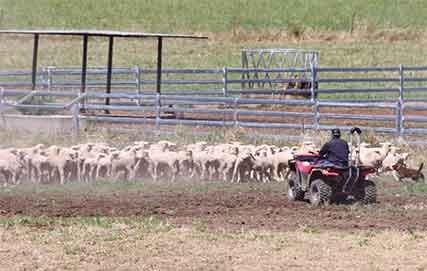 Lamb producers can expect to see prices climbing into the spring to hit a high of 1000-1050ckg as the Aussie protein continues to be the new Wagyu in the US.
Lamb producers can expect to see prices climbing into the spring to hit a high of 1000-1050ckg as the Aussie protein continues to be the new Wagyu in the US.
But domestically, labour shortages continue to be a problem as processors concentrate on markets at home, with tight wholesale margins and no bargains in the meat counter.
According to market analyst Simon Quilty, Global AgriTrends, fresh lamb prices are up 10 per cent in the US, and in terms of sales are up 1.5 per cent.
Fresh beef, chicken and pork prices are up 10 per cent but volumes are down from 4 to 8 per cent, meaning customer push-back at the higher prices.
“It is unbelievable how lamb has taken off in America and it is the new Wagyu meaning it is an elite product in that market,” Mr Quilty said.
“For the lamb sector we will see a trading range of 800-1066c/kg over the next few years and lamb looks like it will be in great shape.
“American prices next year will go 16 per cent higher for beef and lamb, and with that global beef and lamb prices will move higher. When America lifts prices, it enables Australia to lift prices.”
In Australia’s domestic market, labour continues to be a challenge with visa applications down 39 per cent in the last two to three years.
“This has plateaued out in the last two quarters but we still have a serious shortage – the 188 million global workers have been stopped in terms of movement for the last two years,” Mr Quilty said.
“Effectively what we need is for them to be back working and travelling. Lamb prices are far lower than what they should be due to the lack of workers, especially in Victoria.
“But I am bullish about lamb prices at the back end of this year reaching 1000-1050c/kg, with the spread between heavy and light lambs widening dramatically.”
Speaking at the Pasture Agronomy Service conference in Wagga Wagga on May 25, Mr Quilty said beef producers could expect Jap ox/heavy steer prices to fall at gradual pace, while the Eastern Young Cattle Indicator to have a soft landing and bottom out at 800c/kg in 2024, followed by a gradual improvement.
The US has forecast 1.8 billion pounds (858,000 metric tonnes) of beef less in the domestic market next year due to drought, or a 7 per cent fall, while the US export market is tipped to fall by 193,000 metric tonnes.
An indicator of herd liquidation, the average US weekly cow slaughter is tracking six per cent higher than last year resulting in a 1.2 million head loss from the top 10 beef cow states.
“The clear message is things are tightening. Globally there is a 318,000 metric tonnes shortage this year and next year looks even tighter,” Mr Quilty said.
“Australian exports are on this track this year to be 5 per cent lower, Brazil down by 90,000 tonnes, Uruguay down by 10 per cent, and Argentina is down this year by 38,000 tonnes or 5. 2 per cent.”
The estimated USD $18 trillion global COVID stimulus has led to overloaded supply chains, container shortages, rampant inflation, rising labour, fuel and electricity costs, and surging feed and input costs.
Corn prices are tipped to rise on the back of the Russia-Ukraine conflict, depressing carcase weights in cattle on feed.
Australia has announced a record number of cattle on feed for the last quarter at 1.2 million head to service the Wagyu and high-end grain fed export markets.
Australian Wagyu striploin and ribeye cuts are returning USD $53/pound or AUS$120/kg in the US while tenderloins are trading at US$50/pound.
“The young Wagyu index in Australia is trading at 1050c/kg and as long as that demand continues in America, I expect that price to remain firm in terms of feeder steers,” Mr Quilty said.
“The Eastern Young Cattle Indicator will hold firm for the next five to six months but we may see some challenges by the final quarter where I expect we could be getting falls to 950c/kg.
“In recent times Angus feeder steers were at 590c/kg, today at 635c/kg and I expect them to remain firm.
“I am cautiously optimistic when it comes to China but all the latest indicators we look at are struggling so it will be interesting to see what happens as the last time a COVID spike occurred in 2020 there was a 21 per cent fall in beef prices. I don’t think that will happen again. “
